Surface Nitridation of Aluminum Nanoparticles by Off-Line Operation and Its Kinetics Analysis
Abstract
:1. Introduction
2. Experimental Section
3. Results and Discussion
3.1. Structural and Elemental Analysis
3.1.1. Transmission Electron Microscopy (TEM)
3.1.2. X-ray Diffraction (XRD)
3.1.3. X-ray Photoelectron Spectroscopy (XPS)
3.2. Differential Scanning Calorimetry—Thermogravimetry (DSC-TG) Analysis
3.2.1. Study Conducted between 25 and 700 °C at Different Heating Rates
3.2.2. Study Conducted between 25 and 1300 °C
3.3. Non-Isothermal Reaction Kinetics
4. Conclusions
Supplementary Materials
Acknowledgments
Author Contributions
Conflicts of Interest
References
- Mench, M.M.; Kuo, K.K.; Yeh, C.L.; Lu, Y.C. Comparison of thermal behavior of regular and ultra-fine aluminum powders (Alex) made from plasma explosion process. Combust. Sci. Technol. 1998, 135, 269–292. [Google Scholar] [CrossRef]
- Kwon, Y.S.; Gromov, A.A.; llyin, A.P.; Rim, G.H. Passivation process for superfine aluminum powders obtained by electrical explosion of wires. Appl. Surf. Sci. 2003, 211, 57–67. [Google Scholar] [CrossRef]
- Sarathi, R.; Sindhu, T.K.; Chakravathy, S.R. Impact of binary gas on nano-aluminium particle formation through wire explosion process. Mater. Lett. 2007, 61, 1823–1826. [Google Scholar] [CrossRef]
- Gromov, A.A.; Förter-Barth, U.; Teipel, U. Aluminum nanopowders produced by electrical explosion of wires and passivated by non-inert coatings: Characterisation and reactivity with air and water. Powder Technol. 2006, 164, 111–115. [Google Scholar] [CrossRef]
- Farhat, Z.N.; Ding, Y.; Northwood, D.O.; Alpas, A.T. Effect of grain size on friction and wear of nanocrystalline aluminum. Mater. Sci. Eng. A 1996, 206, 302–313. [Google Scholar] [CrossRef]
- Laha, T.; Agarwal, A.; Mckechnie, T.; Rea, K.; Seal, S. Synthesis of bulk nanostructured aluminum alloy component through vacuum plasma spray technique. Acta Mater. 2005, 53, 5429–5438. [Google Scholar] [CrossRef]
- Abdoli, H.; Ghanbari, M.; Baghshahi, S. Thermal stability of nanostructured aluminum powder synthesized by high-energy milling. Mater. Sci. Eng. A 2011, 528, 6702–6707. [Google Scholar] [CrossRef]
- Zhao, K.Y.; Li, C.J.; Tao, J.M.; Ng, D.H.L.; Zhu, X.K. The synthesis, microstructure, hardness and thermal properties of bulk nanocrystalline Al produced by in situ consolidation with low-energy ball milling. J. Alloys Compd. 2010, 504, S306–S310. [Google Scholar] [CrossRef]
- Cai, B.; Kong, Q.P.; Cui, P.; Cong, H.T.; Sun, X.K. Internal friction of nanocrystalline aluminum prepared by plasma evaporation and compaction. Scr. Mater. 2001, 44, 1043–1048. [Google Scholar] [CrossRef]
- Hung, P.C.; Sun, P.L.; Yu, C.Y.; Kao, P.W.; Chang, C.P. Inhomogeneous tensile deformation in ultrafine-grained aluminum. Scr. Mater. 2005, 53, 647–652. [Google Scholar] [CrossRef]
- Alihosseini, H.; Zaeem, M.A.; Dehghani, K.; Shivaee, H.A. Producing ultrafine-grained aluminum rods by cyclic forward-backward extrusion: Study the microstructures and mechanical properties. Mater. Lett. 2012, 74, 147–150. [Google Scholar] [CrossRef]
- Lei, H.L.; Tang, Y.J.; Li, J.; Luo, J.S.; Li, X.B. In situ organic coating of metal nanoparticles. Appl. Phys. Lett. 2006, 88, 083111. [Google Scholar] [CrossRef]
- Foley, T.J.; And, C.E.J.; Higa, K.T. Inhibition of oxide formation on aluminum nanoparticles by transition metal coating. Chem. Mater. 2005, 17, 4086–4091. [Google Scholar] [CrossRef]
- Guo, L.; Song, W.; Xie, C.; Zhang, X.; Hu, M. Characterization and thermal properties of carbon-coated aluminum nanoparticles prepared by laser-induction complex heating in methane. Mater. Lett. 2007, 61, 3211–3214. [Google Scholar] [CrossRef]
- Tillotson, T.M.; Gash, A.E.; Simpson, R.L.; Hrubesh, L.W.; Satcher, J.H., Jr.; Poco, J.F. Nanostructured energetic materials using sol–gel methodologies. J. Non-Cryst. Solids 2001, 285, 338–345. [Google Scholar] [CrossRef]
- Kwon, Y.S.; Gromov, A.A.; Llyin, A.P. Reactivity of superfine aluminum powders stabilized by aluminum diboride. Combust. Flame 2002, 131, 349–352. [Google Scholar] [CrossRef]
- Jouet, R.J.; Warrent, A.D.; Rosenberg, D.M.; Bellitto, V.J.; Park, K.-H.; Zachariah, M.R. Surface passivation of bare aluminum nanoparticles using perfluoroalkyl carboxylic acids. Chem. Mater. 2005, 17, 2987–2996. [Google Scholar] [CrossRef]
- Mary, B.; Dubois, C.; Carreau, P.J.; Brousseau, P. Rheological properties of suspensions of polyethylene-coated aluminum nanoparticles. Rheol. Acta 2006, 45, 561–573. [Google Scholar] [CrossRef]
- Guo, L.; Song, W.; Hu, M.; Xie, C.; Chen, X. Preparation and reactivity of aluminum nanoparticles coated by hydroxyl-terminated polybutadiene. Appl. Surf. Sci. 2008, 254, 2413–2417. [Google Scholar] [CrossRef]
- Lee, S.H.; Yi, J.H.; Kim, J.H.; Ko, Y.N.; Hong, Y.J.; Kang, Y.C. Preparation of nanometer AlN powders by combining spray pyrolysis with carbothermal reduction and nitridation. Ceram. Int. 2011, 37, 1967–1971. [Google Scholar] [CrossRef]
- Weimer, A.W.; Cochran, G.A.; Eisman, G.A.; Henley, J.P.; Hook, B.D.; Mills, L.K.; Guiton, T.A.; Knudsen, A.K.; Nichols, N.R.; Volmering, J.E.; et al. Rapid process for manufacturing aluminum nitride powder. J. Am. Ceram. Soc. 1994, 77, 3–8. [Google Scholar] [CrossRef]
- Hou, X.; Chou, K.C.; Zhang, X.; Seetharaman, S. Oxidation kinetics of aluminum nitride at different oxidizing atmosphere. J. Alloys Compd. 2008, 465, 90–96. [Google Scholar] [CrossRef]
- Hou, X.M.; Yue, C.S.; Singh, A.K.; Zhang, M.; Chou, K.C. Morphological development and oxidation mechanisms of aluminum nitride whiskers. J. Solid State Chem. 2010, 183, 963–968. [Google Scholar] [CrossRef]
- Hasani, S.; Panjepour, M.; Shamanian, M. Non-isothermal kinetic analysis of oxidation of pure aluminum powder particles. Oxid. Met. 2014, 81, 299–313. [Google Scholar] [CrossRef]
- Fryt, E.M. Application of the Rosenburg kinetic method for determination of the parabolic rate constants for metal oxidation. Oxid. Met. 1978, 12, 139–156. [Google Scholar] [CrossRef]
- Linevsky, M.J.; White, D.; Mann, D.E. Infrared spectrum and structure of gaseous Al2O. J. Chem. Phys. 1964, 41, 542–545. [Google Scholar] [CrossRef]
- Vyazovkin, S.V.; Lesnikovich, A.I.; Goryachko, V.I. A method of comparing kinetic curves obtained under isothermal and nonisothermal. Thermochim. Acta 1990, 165, 259–264. [Google Scholar] [CrossRef]
- Kissinger, H.E. Reaction kinetics in differential thermal analysis. Anal. Chem. 1957, 29, 1702–1706. [Google Scholar] [CrossRef]
- Kuo, K.K.; Deluca, L.T. Combustion of Energetic Materials; Begell House Inc.: New York, NY, USA, 2001. [Google Scholar]
- Sossi, A.; Duranti, E.; Paravan, C.; Deluca, L.T.; Vorozhtsov, A.B.; Gromov, A.A.; Pautova, Y.I.; Lerner, M.I.; Rodkevich, N.G. Non-isothermal oxidation of aluminum nanopowder coated by hydrocarbons and fluorohydrocarbons. Appl. Surf. Sci. 2013, 271, 337–343. [Google Scholar] [CrossRef]
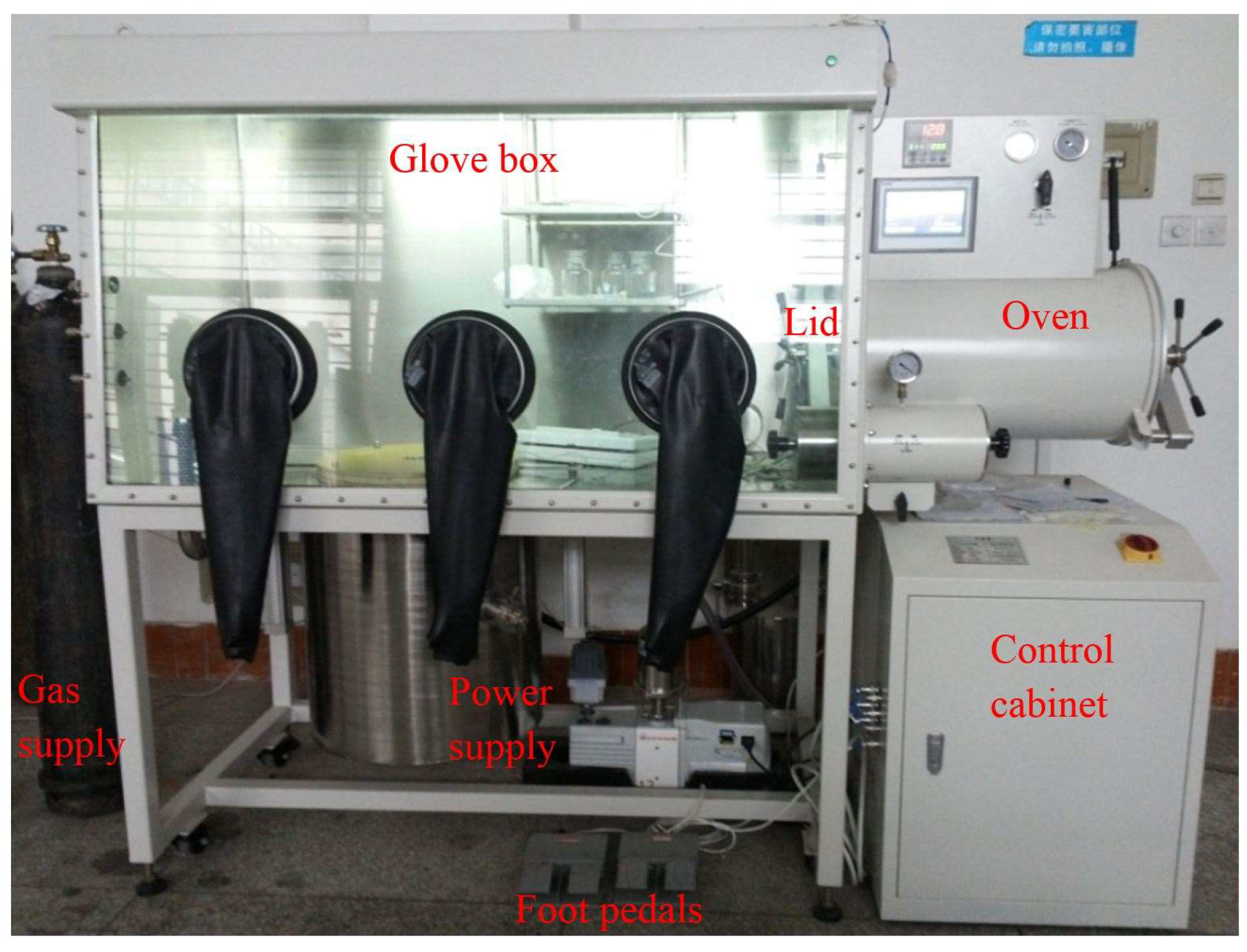

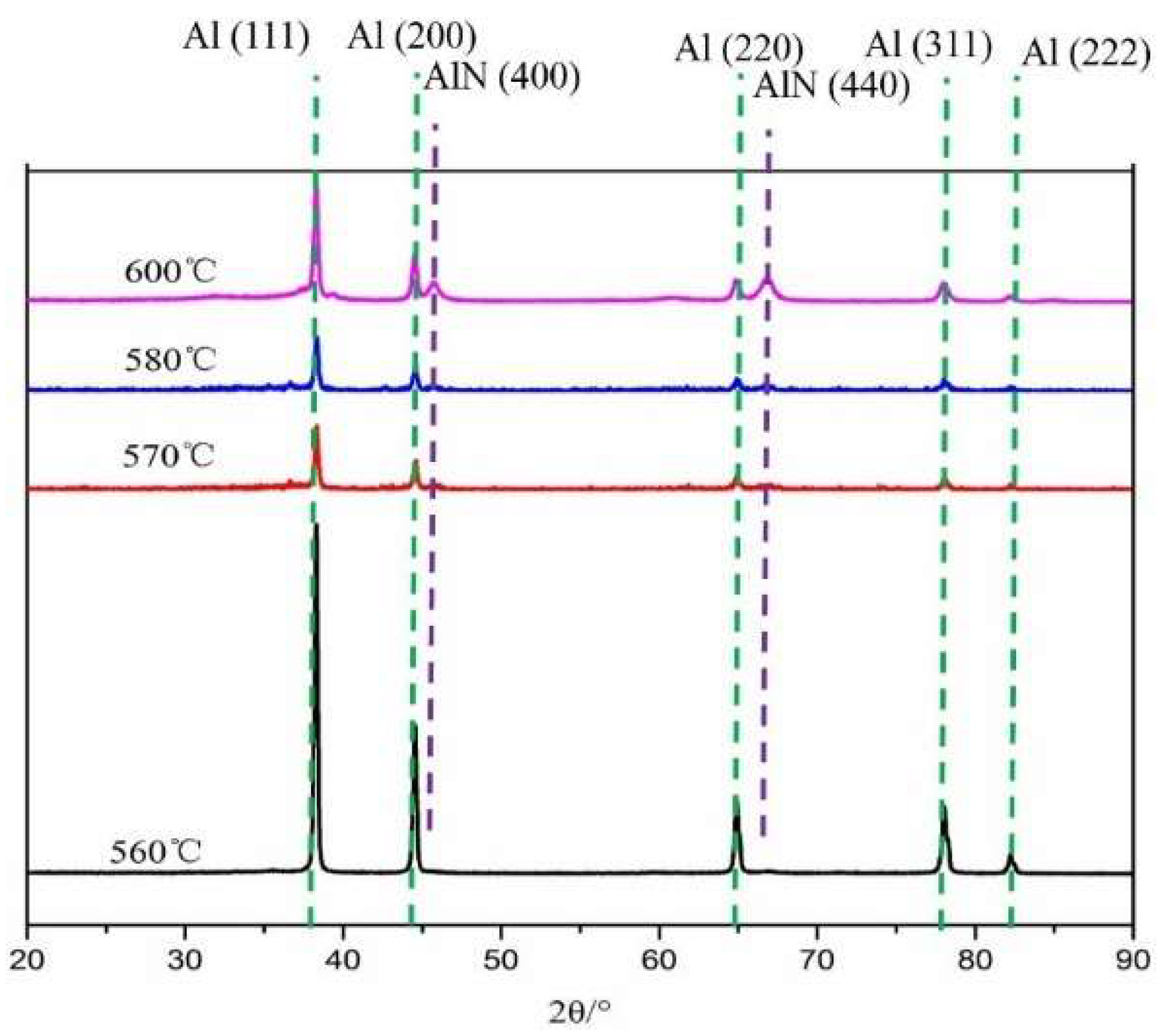
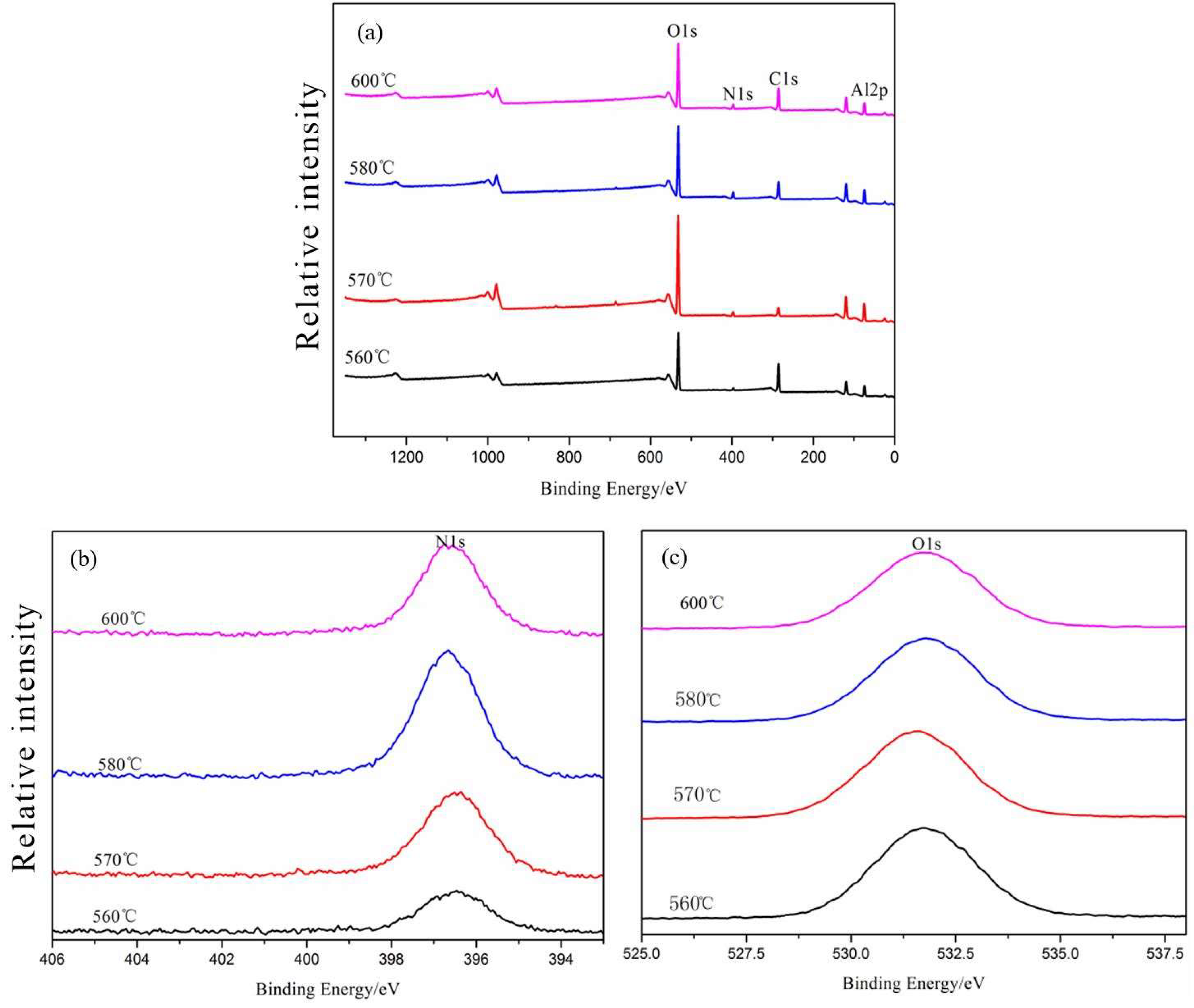

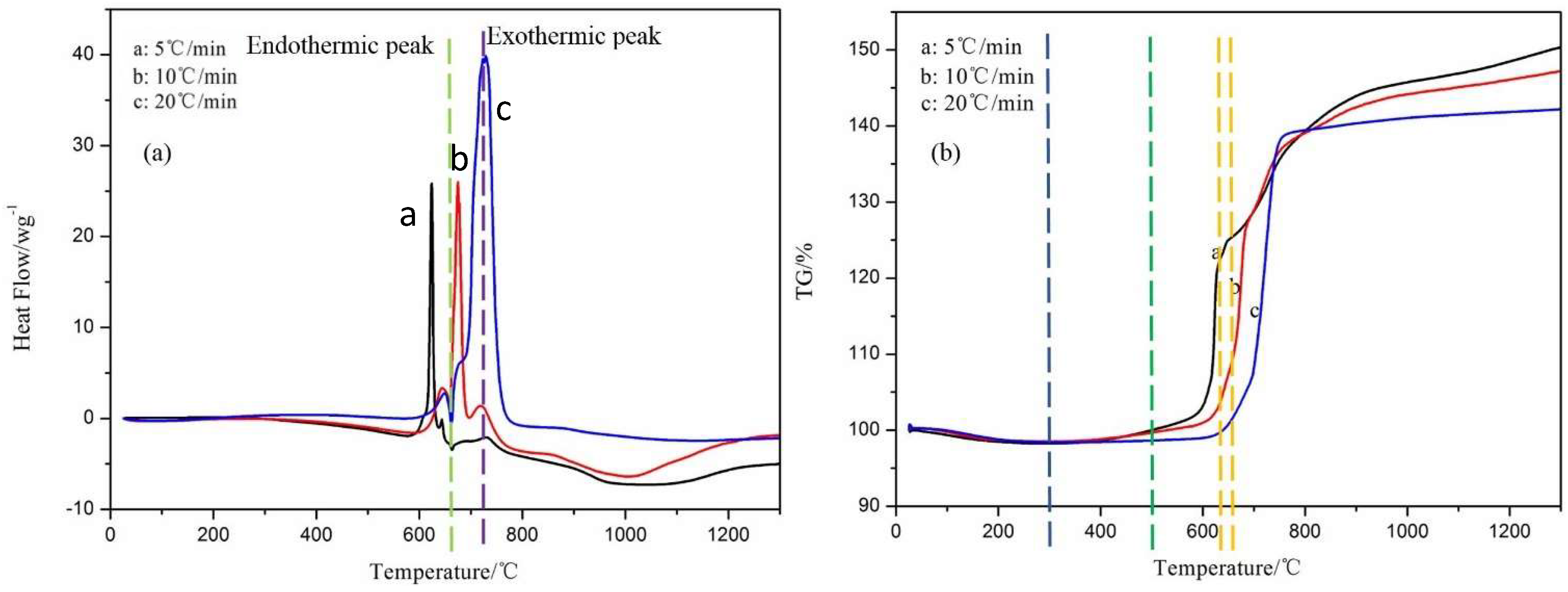
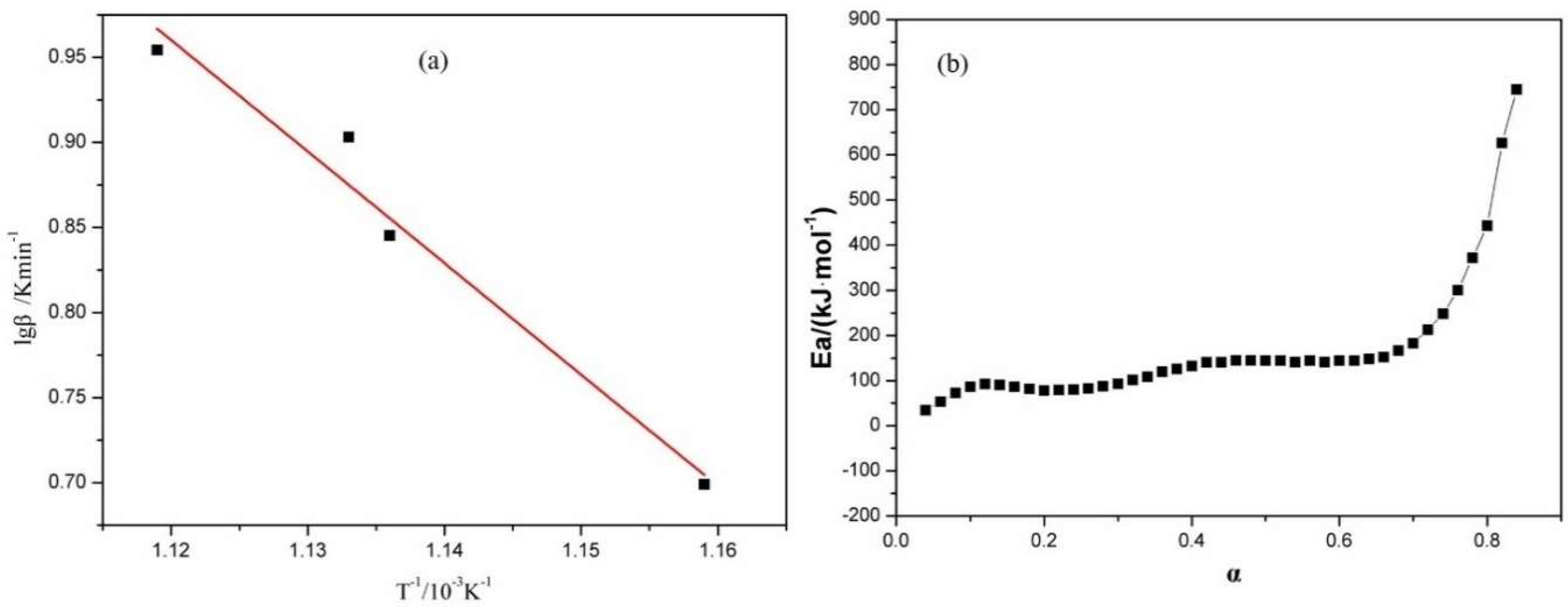
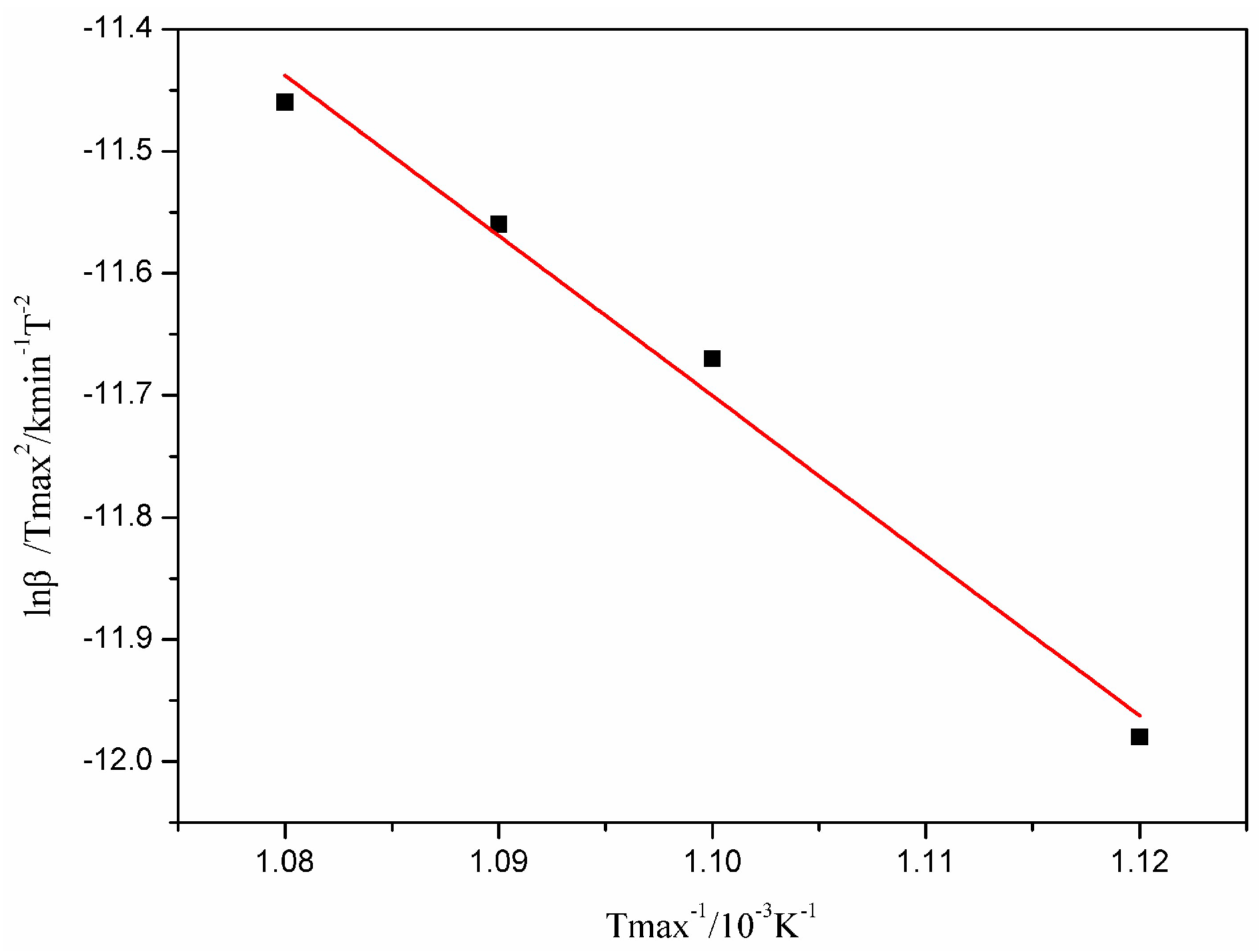
| Method | Equation | |
|---|---|---|
| Ordinary-Integral | (1) | |
| MacCallum-Tanner | (2) | |
| Satava-Setak | (3) | |
| Agrawal | (4) | |
| Flynn-Wall-Ozawa | (5) | |
| Kissinger | (6) |
| Method | β/(°C·mol−1) | Ea/(kJ·mol−1) | lg(A·S−1) | r | Q |
|---|---|---|---|---|---|
| Ordinary-Integral | 5 | 102.18 | 2.71 | 0.9976 | 0.1220 |
| 7 | 117.59 | 3.71 | 0.9981 | 0.3198 | |
| 8 | 102.27 | 2.78 | 0.9975 | 0.1981 | |
| 9 | 117.62 | 3.69 | 0.9981 | 0.4535 | |
| MacCallum-Tanner | 5 | 103.29 | 2.88 | 0.9962 | 0.0237 |
| 7 | 115.61 | 3.96 | 0.9960 | 0.0615 | |
| 8 | 103.06 | 2.90 | 0.9961 | 0.0385 | |
| 9 | 114.68 | 3.61 | 0.9967 | 0.0594 | |
| Satava-Sestak | 5 | 110.40 | 3.54 | 0.9976 | 0.0134 |
| 7 | 125.28 | 4.43 | 0.9981 | 0.0241 | |
| 8 | 110.71 | 3.86 | 0.9975 | 0.0202 | |
| 9 | 125.48 | 4.42 | 0.9981 | 0.0873 | |
| Agrawal | 5 | 102.18 | 2.71 | 0.9976 | 0.1220 |
| 7 | 117.59 | 3.71 | 0.9981 | 0.3198 | |
| 8 | 102.27 | 2.78 | 0.9975 | 0.1981 | |
| 9 | 117.62 | 3.69 | 0.9981 | 0.4535 | |
| Mean | - | 111.74 | 3.46 | - | - |
| Flynn-Wall-Ozawa | - | 118.8 | - | 0.9994 | - |
| Kissinger | - | 109.03 | 5.2 | 0.9998 | - |
© 2018 by the authors. Licensee MDPI, Basel, Switzerland. This article is an open access article distributed under the terms and conditions of the Creative Commons Attribution (CC BY) license (http://creativecommons.org/licenses/by/4.0/).
Share and Cite
Yi, Y.; Li, D.; Ma, D.; Luo, D.; Yang, W.; Ma, W. Surface Nitridation of Aluminum Nanoparticles by Off-Line Operation and Its Kinetics Analysis. Metals 2018, 8, 289. https://doi.org/10.3390/met8040289
Yi Y, Li D, Ma D, Luo D, Yang W, Ma W. Surface Nitridation of Aluminum Nanoparticles by Off-Line Operation and Its Kinetics Analysis. Metals. 2018; 8(4):289. https://doi.org/10.3390/met8040289
Chicago/Turabian StyleYi, Yong, Dai Li, Daichuan Ma, Daibing Luo, Weizhong Yang, and Wangjing Ma. 2018. "Surface Nitridation of Aluminum Nanoparticles by Off-Line Operation and Its Kinetics Analysis" Metals 8, no. 4: 289. https://doi.org/10.3390/met8040289
APA StyleYi, Y., Li, D., Ma, D., Luo, D., Yang, W., & Ma, W. (2018). Surface Nitridation of Aluminum Nanoparticles by Off-Line Operation and Its Kinetics Analysis. Metals, 8(4), 289. https://doi.org/10.3390/met8040289







